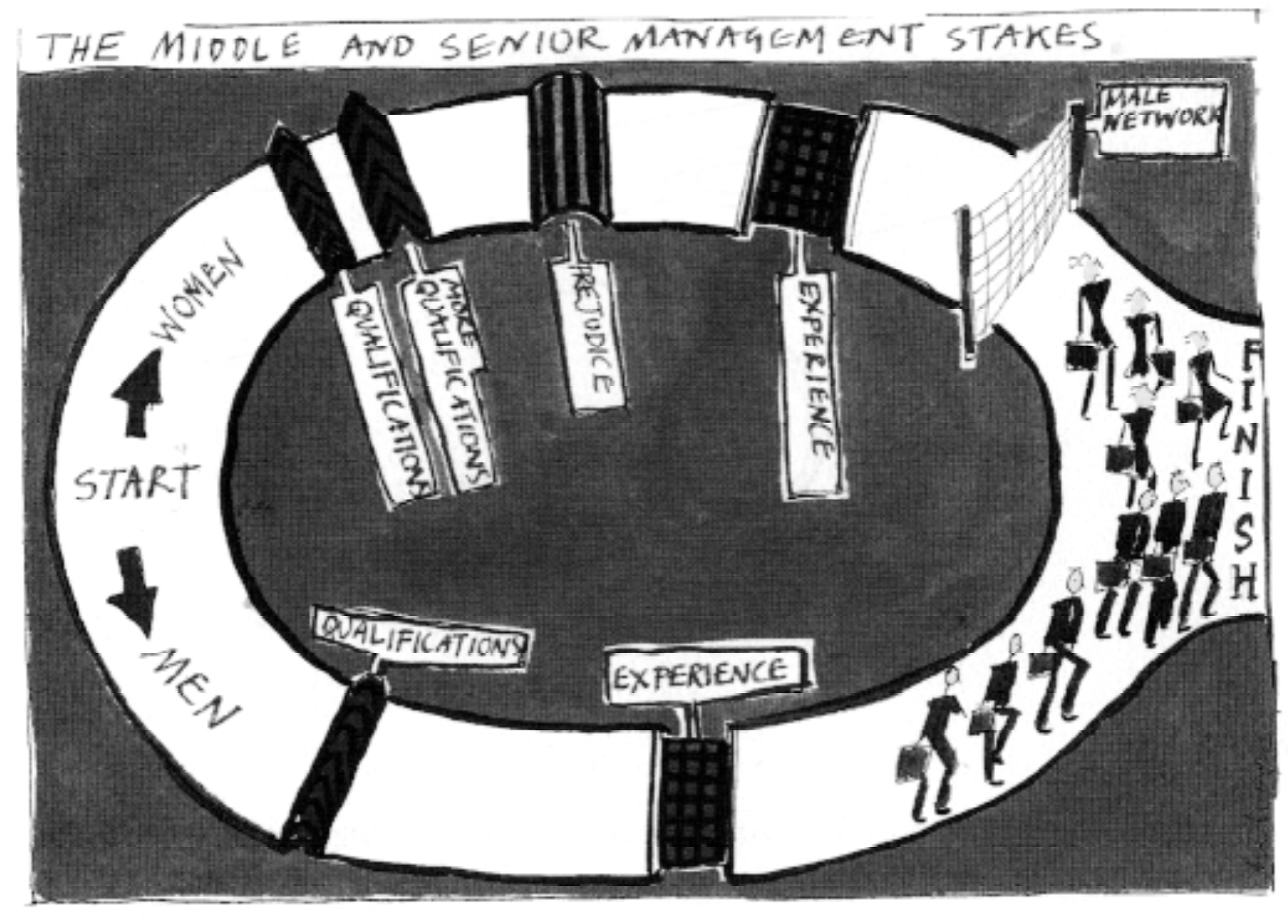در صورتی که اشکالی در ترجمه می بینید می توانید از طریق شماره زیر در واتساپ نظرات خود را برای ما بفرستید
09331464034Why some women cross the finish line ahead of men
چرا بعضی زن ها زودتر از مردان به خط پایان می رسند

 Women who apply for jobs in middle or senior management have a higher success rate than men, according to an employment <strong>survey.</strong>
Women who apply for jobs in middle or senior management have a higher success rate than men, according to an employment <strong>survey.</strong>
بر اساس یک <strong>نظرسنجی</strong> درباره استخدام، زنانی که برای شغل مدیریت میانی یا ارشد درخواست می دهند، نسبت به مردان موفق تر هستند.
But of course far fewer of them apply for these positions. The study, by <strong>recruitment</strong> consultants NB Selection, shows that while one in six men who appear on interview shortlists get jobs, the figure rises to one in four for women.
اما مطمئناً تعداد بسیار کمتری از آنها متقاضی این موقعیت ها هستند. این مطالعه، توسط مشاوران <strong>استخدام</strong> ان بی سلکشن، نشان می دهد در حالی که از هر شش مردی که در لیست نهایی مصاحبه حضور دارند، یک نفر شغل را به دست می آورد، برای زنان این رقم به یک نفر از هر 4 نفر افزایش می یابد.
The study <strong>concentrated</strong> on applications for management positions in the $45,000 to $110,000 salary range and found that women are more successful than men in both the private and public sectors.
این مطالعه بر درخواست های مشاغل مدیریتی در محدوده حقوق 45000 تا 110،000 $ <strong>تمرکز</strong> داشت و نشان داد که زنان نسبت به مردان هم در بخش های خصوصی و هم دولتی موفق تر هستند.
Dr Elisabeth Marx from London-based NB Selection described the findings <strong>as encouraging</strong> for women, in that they send a positive message to them to apply for interesting management positions.
دکتر الیزابت مارکس از ان بی سلکشن در لندن این یافته ها را یافته هایی<strong> تشویق کننده</strong> برای زنان خواند، چرا که آنها پیام مثبتی به زنان می دهند تا برای موقعیت های جالب مدیریتی درخواست دهند.
But she added, “We should not lose sight of the fact that significantly fewer women apply for <strong>senior</strong> positions in comparison with men.”
اما وی افزود، "ما نباید این واقعیت را از نظر دور کنیم که زنان بسیار کمتری در مقایسه با مردان متقاضی پست های <strong>ارشد</strong> هستند."
Reasons for higher success rates among women are difficult to isolate. One explanation suggested is that if a woman candidate manages to get on a shortlist, then she has probably already proved herself to be an <strong>exceptional</strong> candidate.
جدا کردن دلایل موفقیت بالاتر در زنان دشوار است. یکی از توضیحاتی که ارائه شده این است که اگر یک زن کاندیدا موفق به ورود به لیست نهایی شود، احتمالاً از قبل خود را به عنوان یک کاندیدای <strong>استثنایی</strong> ثابت کرده است.
Dr Marx said that when women apply for positions they tend to be better qualified than their male <strong>counterparts</strong> but are more selective and conservative in their job search.
دکتر مارکس گفت که هنگامی که زنان برای موقعیت هایی درخواست می دهند، معمولا از <strong>همتایان</strong> مرد خود بیشتر واجد شرایط هستند اما در جستجوی کار گزینش و محافظه کاری بیشتری دارند.
Women tend to research thoroughly before applying for positions or attending interviews. Men, on the other hand, seem to rely on their ability to sell themselves and to convince employers that any <strong>shortcomings</strong> they have will not prevent them from doing a good job.
زنان تمایل دارند قبل از اقدام به درخواست برای موقعیت ها یا شرکت در مصاحبه ها، کاملا تحقیق کنند. از طرف دیگر، به نظر می رسد مردان به توانایی خود در به نمایش گذاشتن قابلیت هایشان متكی هستند و كارفرمایان را متقاعد می كنند كه هر <strong>نقصی</strong> كه دارند مانع انجام خوب كار آنها نمی شود.
Managerial and executive progress made by women is <strong>confirmed</strong> by the annual survey of boards of directors carried out by Korn/Ferry/Carre/ Orban International. This year the survey shows a doubling of the number of women serving as non-executive directors compared with the previous year.
پیشرفت های مدیریتی و اجرایی زنان توسط نظرسنجی سالانه هیئت مدیره انجام شده توسط کورن/فری/کار/اربان اینترنشنال <strong>تأیید</strong> شده است. امسال این نظرسنجی افزایش دوبرابری تعداد زنانی را که به عنوان مدیر غیر اجرایی مشغول به کار هستند نسبت به سال قبل نشان می دهد.
However, progress remains painfully slow and there were still only 18 posts filled by women out of a total of 354 <strong>nonexecutive</strong> positions surveyed.
با این حال، این پیشرفت به طرز دردناکی آهسته باقی مانده است و هنوز تنها 18 موقعیت از مجموع 354 موقعیت <strong>غیراجرایی</strong> بررسی شده توسط زنان پر شده است.
Hilary Sears, a partner with Korn/Ferry, said, “Women have raised the level of grades we are employed in but we have still not broken through barriers to the top.”
هیلاری سیرز، یکی از شرکای شرکت کورن/ فری، گفت: "زنان سطح درجاتی را که در آنها استخدام می شویم افزایش داده اند اما هنوز موانع رسیدن به سطوح بالاتر را نتوانسته ایم شکست دهیم."
In Europe a recent feature of corporate life in the <strong>recession</strong> has been the <strong>delayering</strong> of management structures.
در اروپا یکی از ویژگیهای اخیر زندگی شرکتها در دوران <strong>رکود اقتصادی</strong>،<strong> لایه زدایی</strong> ساختارهای مدیریتی بوده است.
Sears said that this has halted progress for women in as much as de-layering has taken place either where women are working or in layers they <strong>aspire</strong> to.
سیرز گفت که این امر پیشرفت زنان را متوقف کرده است، چرا که لایه زدایی یا در جاهایی که زنان کار می کنند صورت گرفته یا در جاهایی که آنها <strong>آرزو</strong> دارند در آنها کار کنند.
Sears also noted a positive trend from the <strong>recession,</strong> which has been the growing number of women who have started up on their own.
سیرز همچنین به یک روند مثبت در<strong> رکود اقتصادی</strong> اشاره کرد، یعنی افزایش تعداد زنانی که به تنهایی کار خود را شروع کرده اند.
In business as a whole, there are a number of factors encouraging the <strong>prospect</strong> of greater equality in the workforce. Demographic trends suggest that the number of women going into employment is steadily increasing.
به طور كلی در مشاغل، تعدادی عامل تشویق كننده برای <strong>ایجاد</strong> تساوی بیشتر در نیروی كار وجود دارد. روندهای جمعیتی نشان می دهد که تعداد زنانی که مشغول کار می شوند به طور پیوسته در حال افزایش است.
In addition a far greater number of women are now passing through higher education, making them better <strong>qualified</strong> to move into management positions.
بعلاوه، تعداد بسیار بیشتری از زنان اکنون تحصیلات عالی را پشت سر می گذارند و این باعث می شود که آنها از <strong>شرایط بهتری</strong> برای انتقال به سمتهای مدیریتی برخوردار شوند.
Organisations such as the European Women’s Management Development Network provide a range of opportunities for women to <strong>enhance</strong> their skills and contacts.
سازمان هایی مانند شبکه توسعه مدیریت زنان اروپا طیف وسیعی از فرصت ها را برای <strong>بهبود</strong> مهارت ها و ارتباطات زنان فراهم می کنند.
Through a series of both pan-European and national workshops and conferences the <strong>barriers</strong> to women in employment are being broken down.
از طریق مجموعه ای از کارگاه ها و کنفرانس های پان اروپایی و ملی، <strong>موانع</strong> اشتغال زنان در حال از بین رفتن هستند.
However, Ariane Berthoin Antal, director of the International Institute for Organisational Change of Archamps in France, said that there is only <strong>anecdotal</strong> evidence of changes in recruitment patterns.
با این حال، آریان برتوین آنتال، مدیر انستیتوی بین المللی تغییر سازمانی آرکامپس در فرانسه، گفت که فقط <strong>روایت</strong> هایی از تغییر در الگوهای استخدام وجود دارد.
And she said, “It’s still so hard for women to even get on to shortlists -there are so many <strong>hurdles</strong> and barriers.’ Antal agreed that there have been some positive signs but said “Until there is a belief among employers, until they value the difference, nothing will change.”
و او گفت، "حتی ورود به لیست های نهایی مصاحبه برای زنان بسیار دشوار است- <strong>موانع</strong> و سدهای زیادی در مقابل آنها وجود دارد." آنتال موافقت کرد که علائم مثبتی وجود دارد اما گفت "تا زمانی که اعتقادی در بین کارفرمایان وجود داشته باشد، تا زمانی که آنها ارزشی برای تفاوت ها قائل نشوند، هیچ چیز تغییر نخواهد کرد. "
Questions & answers
Questions 1-6
The reading passage 128 has paragraphs (A-G). State which paragraph discusses each of the points below.
Write the appropriate letter (A-G).
1 The drawbacks of current company restructuring patterns.
2 Associations that provide support for professional women.
3 The success rate of female job applicants for management positions.
4 Male and female approaches to job applications.
5 Reasons why more women are being employed in the business sector.
6 The improvement in female numbers on company management structures.
Questions 7 – 10
The author makes reference to three consultants in the Reading Passage.
Which of the list of points below do these consultants make? Write
M if the point is made by Dr Marx
S if the point is made by Hilary Sears
A if the point is made by Ariane Berthoin Antal
7 Selection procedures do not favour women.
8 The number of female-run businesses is increasing.
9 Male applicants exceed female applicants for top posts.
10 Women hold higher positions now than they used to.
Questions 11 - 14
Using NO MORE THAN THREE WORDS answer the following questions.
11 What change has there been in the number of women in top management positions detailed in the annual survey?
12 What aspect of company structuring has disadvantaged women?
13 What information tells us that more women are working nowadays?
14 Which group of people should change their attitude to recruitment?
Answers:
2 G
3 A
4 C
5 F
6 D
7 A
8 S
9 M
10 S
11 (it has) double(d) / doubling
12 de-layering
13 demographic trends
14 employers
نظرات کاربران
هنوز نظری درج نشده است!